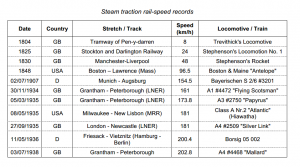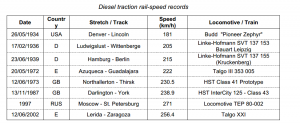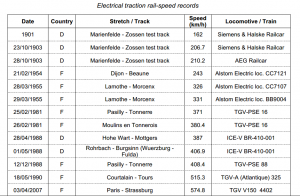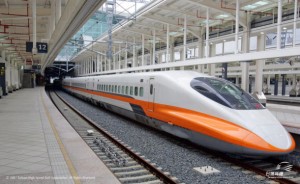High Speed Railways
Understanding High Speed Rail?
UIC definitionTrains running at speed of 200 kmph on upgraded trackTrain running at speed of 250 kmph or faster on new trackis called High Speed Trains.
Wheel was invented around 4000 BC; and two wheel cart followed immediately for transportation of goods. It was soon noticed that harder and smoother surfaces provides ease in transportation. As the loads become heavier, four wheeler carriage took shape. The track become straighter and harder. Efficient transportation system started on rail only, whether it was a horse driven carriage or steam traction at the beginning of the 19th century. It was for the reason that resistance to haul on rail is much less as compared to road. But with the development of petrol/diesel/gas engine, road transport became the most preferred mode of transport because it offer house to house connectivity. Competition between different mode of transport such as air, rail, road and sea starts taking shape.
Human being had the strong desire to cross new frontier in speed and all mode of transport started making use of technology development to touch new records. Beside this, efforts were also to reduce travel time by adopting multi-model mode of transport An individual always look for the total travel time from house to house with comfort and safety instead at speed alone.
The maximum speed attained depends on the following factors:
| Physical Phenomenon and Constraints | Gravity, Aero-dynamics, Adherence, Limits of Power packing |
| Technological Advancements | Traction, Braking, Suspension, Material |
| Social Criteria | Comfort, Safety, Economy, Environment |
Development of Maximum Speed for different mode of transport
Road
| Period | Development of speed |
| 1885-1920 | 25 Kmph -150 Kmph |
| 1920-1930 | 150 Kmph -225 Kmph |
| 1930-1955 | 225 Kmph -250 Kmph |
| 1955-1985 | 250 Kmph -325 Kmph |
| 1985-1990 | 325 Kmph -380 Kmph |
| 1990-2005 | 380 Kmph |
| 2005-2010 | 380 Kmph -418 Kmph |
Even though speed over road developed with new benchmark set regularly but safety was a concern. Years 1934-74 was a period of relentless increase in speed on road but equal jump in fetal accidents, and therefore, maximum speed was fixed at 130 Kmph. The factor that governed fixing maximum speed limit are weather condition, traffic capacity, oil prices, safety and accidentility.
But road was unable to handle bulk transport of daily commuters and this led to development of Sub-urban and urban mode of transport by Rail. Even with last mile connectivity an issue, rail transport is in every one’s liking. Alternatives were developed to offer last mile connectivity like feeder service by rail or road etc. owned by rail authority or city municipality to increase the catchment area.
Air
The level of speed attained are as follows:
| Period | Maximum Speed | Commercial Speed |
| 1905-1945 | 50-1100 Kmph | 50-300 Kmph |
| 1945-1975 | 1100-3300 Kmph | 300-930 Kmph |
| 1975-2005 | 3300-11995 Kmph | 930-2400 Kmph |
| 2005- | 930 Kmph |
Concorde achieved the maximum commercial speed of 2400 Kmph but was grounded in 2005 after a disastrous accident.
Rail
Different Mode of traction i.e. Steam, Diesel and Electric achieved different level of maximum speed as given below:
Steam: Steam is generated in the engine and used to work a piston, rod of which is connected to wheel.
Diesel: There are two ways of Diesel Traction namely Diesel-electric and Diesel Hydraulic. In diesel electric, electric power is generated by diesel engine which works the traction motor. In diesel hydraulic, diesel engine drives a hydraulic transmission, which turn the wheels via a gearbox. The maximum speed achieved in 2002 was with hydraulic transmission.
Electric: High Speed needs power packing and with electic traction it is possible therefore, higher speeds could be achieved.
The commercial speed also increased with the development of maximum speed and were in the range of 320-350 kmph. There were few fetal accidents of high speed train recently in China and Spain. The pace of China’s high-speed rail expansion slowed sharply in 2011 after the removal of Chinese Railways Minister Liu Zhijun in February pending investigation for corruption and a fatal high-speed railway accident near Wenzhou in July. Concerns about HSR safety, high ticket prices, low ridership, financial sustainability of high speed rail projects and environmental impact have drawn greater scrutiny from the Chinese press. China reduced its commercial speed from 350 Kmph to 300 Kmph.
Fact of the matter is that higher and higher speeds were achieved in all the mode of transport during 20th Century, but with safety issues sufacing out in 21st Century
Viability of High Speed System
This is how an article on “High Speed Rail is no solution” in US describes link: http://www.cato.org/publications/commentary/highspeed-rail-is-no-solution
Americans who have ridden French or Japanese high-speed trains often wonder why such trains won’t work here. The problem is, they don’t work that well in France or Japan.
France and Japan have each spent roughly (after adjusting for inflation) the same amount of money per capita on high-speed rail as the United States spent on the interstate highway system. Americans use the interstates to travel nearly 4,000 passenger miles and ship more than 2,000 ton-miles of freight per person per year.
By comparison, high-speed rail moves virtually no freight and carries the average resident of Japan less than 400 miles per year, and the average resident of France less than 300 miles per year. It is likely that a few people use them a lot, and most rarely or not at all.
While working out this figure for Indian Railways, it works out to 600 miles (960 Km) per year but with 1 Billion tonne of freight traffic.
Excerpts from the SNCF International report on High Speed Rail in India
- Indian Railway launched pre-feasibility study of 6 potential high-speed railway service corridors in Sept. 2007. The corridors are
- Mumbai-Ahmedabad srving nasik and Pune
- Delhi-Chandigarh-Amritsar
- Bangalore-hubli-Mysore
- Chennai-Bangalore-Madurai-Coimbatore
- Hyderabad-Bangalore-Vijayawada-Machilipatnam-Chennai
- Kolkata-Haldia
- Delhi-Chandigarh-Amritsar (0-254-487 Km) taken as priority study area with distance to be covered in 50 and 105 minutes from Delhi to Chandigarh and Amritsar respectively.
- In the light of the French experience, beyond certain distance (within 200-1000 Km) and journey times (within 1 hour and 4 hours) the high speed rail market is no longer relevant. This is for the reason that the competition of rail is with air.
- Maximum, commercial and average speed of the network are 350 Kmph, 280 Kmph and 255 kmph respectively.
- As per the document the transport demand for different modes during 2006 is as follows:
|
- Comment: Market share has not been worked out for different distance band, but as our knowledge goes, bus and private cars are popular for distance range of 200-250 Km.
- Passenger traffic forecasting methods has been given based on generalized cost which takes into consideration the cost of waiting time or pre-departure formalities. It has been assessed for the passenger spending idling time before the commencement and after the completion of the journey. It is stated that there exists a time value h0, below which the passenger chooses the train and above which, he chooses the flight. h0 is called the time indifference value.
- Comment: In the context of India, the journey time from residence to Railway Station or Airport should also be taken into consideration on both the legs of the journey. All equations will change. Journey time from New Delhi to Chandigarh is assessed to be 55 minutes, but when added with 55 minutes at both the legs of the journey, the total current journey time become 165 minutes. Unless metro transport is improved, h0 is meaning less. Beside this, security check before entering into Railway station has already started in India. This will also be a must for high-speed train whenever becomes a reality.
- Yearly traffic of 57.3 million passengers has been assessed i.e. 157000 passengers daily requiring about 70 trains to run each way.
- Fare structure is calculated at the rate of Rs. 4/Km or one way ticket costing Rs. 487×4= Rs. 1948/-; per year with earning estimated of Euro 635 Million.
- Project cost estimate is Euro 3614 million with break up as given below:
|
- The estimate does not included the cost of rakes (train sets). The total requirement of rakes worked out to be 77 in numbers. The cost of a train should be around Rs. 100 Crs.
- The cost of the project in Indian currency is Rupees 361.4×60+77×100=29384 Crs. at 2007 price.
What is the rate of return?
Rate of return worked out to be 8.1% as per the report. This does not include the earning from real estate, property & station development. If the passenger traffic assessment is practical, it may turn out to be a good long term investment for many of the bankers and investors abroad or even in India. The bad experience of Airport Link Express and slow progress of Reliance Infra in Mumbai is acting as a dampener.
Success story of MRTS projects may attract long term investors one day





Good afternoon sir ..
Sir mera question ye h ki …… Present m mene abi 12th pass kiya h.
…. And m future m loco pilot ki job k liye apply krna chata hu..
.. So m b.sc electronic se loco pilot k liye apply kr sakta hu …. Ya fir muje iti hi krna chahiye.
.. Sir jaldi btayiye